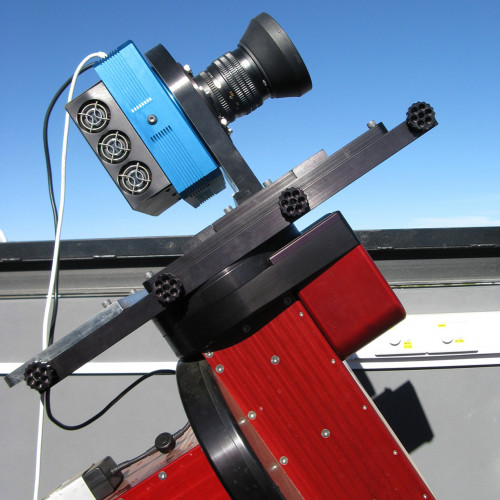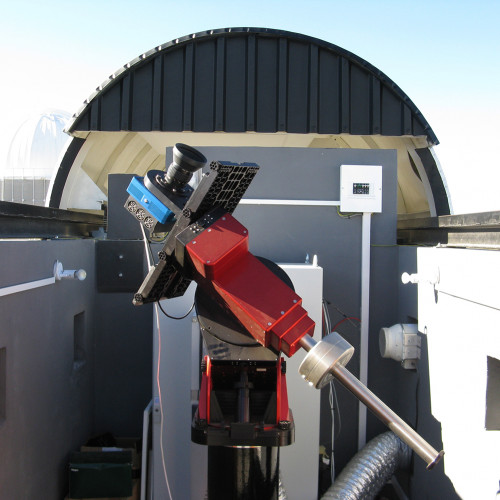Located in Sutherland, South Africa: 280km (174mi) northeast of Cape Town
The second KELT telescope, KELT-South, is located at the Sutherland observing station of the South African Astronomical Observatory (SAAO). The KELT-South telescope sits in a custom-built enclosure that holds the telescope, the control computer, and all the support equipment. The photo below and to the right shows the telescope pointed at the sky in the daytime with the roof rolled off. The photo below and to the left is a closer view, showing the mount, camera, and lens.
KELT-South at Sutherland is located at latitude -32° 23′ 14″ and longitude 20° 48′ 42″ at an elevation of 1798m (5899 feet).

This picture shows the KELT-South telescope at Sutherland.
| Lens | Mamiya 645 80mm f/1.9 |
| Aperture | 42 mm |
| CCD | 4096 x 4096 pixels, Apogee Alta U16M |
| Pixel Size | 9 microns |
| Field of View | 26 x 26 degrees |
| Plate Scale | 23 arcsec/pixel |
| Mount | Paramount ME |

After 14 years of observations, 17 years since the project conception, 26 planets discovered, and dozens of papers, the KELT transit search is ending. This transition has been long-expected, since the NASA TESS mission has revolutionized the discovery of transiting exoplanets. We will continue observations by both KELT telescopes for as long as practical, since there is so much more science to be done outside of transit discovery. Thank you to everyone who supported the KELT project!
... Read MoreWe are honored to have received the Award of Distinction at the 25th Annual Communicator Awards from the Academy of Interactive and Visual Arts for this website, together with our web design partners at 3twenty9 Design, LLC.
... Read More(Phys.org)—An international team of astronomers reports the discovery of a new "hot Jupiter" exoplanet with a short orbital period of just three and a half days. The newly detected giant planet, designated KELT-20b, circles a rapidly rotating star known as HD 185603 (or KELT-20). The finding was presented in a paper published July 5 on arXiv.org.
... Read MoreScientists have discovered a giant ringed gas planet which is likely caused by a mysterious stellar eclipse. The planet has 50 times mass of Jupiter and it is surrounded by a ring of dust. According to researchers from the University of Warwick, this planet is hurtling around a star more than 1000 light years away from Earth.
... Read More